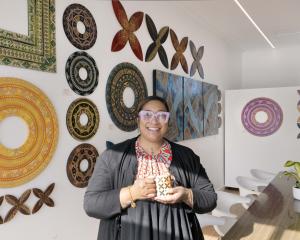
Garry Currin's ambiguous landscapes have a cinematic poetry to them.
Using a minimal palette of sepia brown and steel blue, he has created a distinct world, redolent with echoes of historical New Zealand photographs.
In the current exhibition, Currin has reduced the size of his works to small aluminium plates, on which his oil paintings appear as if contact-printed from ancient photographic negatives.
The forgotten land is rendered mysterious and vague, yet has gained structure, its characters (a rare addition from Currin), looming uncertainly as solid ghosts in the frame.
Even the sprockets and frame lines of the supposed negatives or slides occasionally encroach into the picture area, leaving the viewer seemingly at one stage further removed from the scenes.
The images become narrative storyboards for a history that never was.
Hills and rivers form a tangible backdrop, yet the buildings and structures remain hints, with the imagination of the viewer filling in the blanks.
And that imagination conjures up not just towns and roads, but spectres: skull-like forms, and mysterious creatures which suggest that the land holds more mysteries than we might instantly see.
The exhibition is yet more proof, if any were needed, of the skills of this exceptional artist.

The Artist's Room is marking its tenth anniversary, no mean feat for a gallery in the current New Zealand art business.
It is celebrating in style, hosting a massive exhibition featuring a wealth of artists, both the usual suspects familiar to the gallery's visitors and a few less-known names.
The works are of uniformly high standard and cover a variety of media, from ink drawings and photographs to bronze sculptures and ceramics.
The exhibition is overwhelming in its scope, with the best part of 50 artists taking part.
As such, singling out individual works seems hardly fair or useful. But while such naming may not seem appropriate, there are many works which do demand mention.
These range from the delightful bronze fisherman by Matt Gauldie to Julie Freeman's excellent pastel studies of farm animals.
Danny Moorwood's craquelure ceramics are also noteworthy, as are Karen Baddock's waxeyes and a series of miniatures by Diana Smillie.
A large landscape by Peter Cleverley is attention-grabbing, as are Meredith Marson's oil portraits.
A semi-abstract work by Peter McLaren, portraits by Barry Ross Smith and Patterson Parkin, and the delicate Nest by Deidre Copeland are also memorable pieces.

German-born artist Sarah Freiburger seems to have succumbed to the joys of the Otago landscape since moving here.
Her current exhibition at Mint present a chronological series of works, begins with two fine images of Monrepos Castle near Stuttgart before presenting a series of works largely based on the southern South Island's scenery.
There is a distinct progression in style in these works.
The German scenes, painted two years ago, are realistic, with the faintest hint of magic realism, but whilst effective works, they do little more than convey the scene (albeit achieving this well).
The Otago works begin by introducing a depth reminiscent of wide-angle photographic panoramas, then develop into a mosaic-like form with hints of computer technology's ''pixellated'' images and of early 20th-century Orphist cubism.
The resulting works, whilst still clearly showing their subject matter, now have their emphasis far more firmly on the emotions, colours, and tones of the land rather than the lines of the original scenes they represent.
In images such as Lake Wanaka in Autumn, the true lines and forms are largely subsumed by the subtle variations of individual colours and the strident clash between the opposing blues and oranges, producing a satisfying effect.












